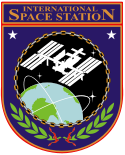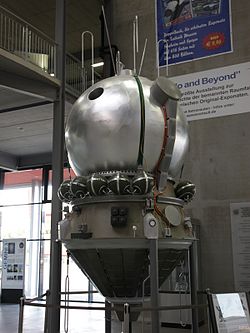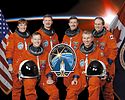STS-115
| STS-115 | |||||
 | |||||
| Uppdrag | 116 | ||||
|---|---|---|---|---|---|
| Rymdfärja | Atlantis (27)[1] | ||||
| NSSDC-ID | 2006-034A[2] | ||||
| Färdens tid | 11 dagar, 19 timmar, 6 minuter, 35 sekunder | ||||
| Uppskjutning | |||||
| Startplats | Pad 39B vid Kennedy Space Center i Florida | ||||
| Start | 9 september 2006 kl 15:14:55 (UTC) | ||||
| Landning | |||||
| Landningsplats | Kennedy Space Center i Florida | ||||
| Landning | 21 september 2006 kl 10:21:30 (UTC) | ||||
| Omloppsbana | |||||
| Varv | 186 st[3] | ||||
| Apogeum | 285 km | ||||
| Perigeum | 229 km | ||||
| Banlutning | 51,6° | ||||
| Sträcka | 7,84 miljoner km | ||||
| Rymdpromenad | |||||
| Antal | 3 st | ||||
| Total tid | 19 timmar, 19 minuter | ||||
| Dockning | |||||
| Rymdstation | ISS | ||||
| Dockning | 11 september 2006, 10:46 UTC | ||||
| Dockningsport | PMA-2 (Destiny, fram) | ||||
| Urdockning | 17 september 2006, 12:50 UTC | ||||
| Tid dockad | 6 dagar, 2 timmar, 4 minuter | ||||
| Besättning | |||||
| Befälhavare | Brent W. Jett (4) | ||||
| Pilot | Christopher Ferguson (1) | ||||
| Uppdragsspecialister | Joseph R. Tanner (4) Daniel C. Burbank (2) Steven MacLean (2) Heidemarie M. Stefanyshyn-Piper (1) | ||||
 | |||||
| Kronologi Rymdfärjeprogrammet | |||||
| |||||
STS-115 var en rymdfärd som genomfördes mellan 9 september och 21 september 2006. Uppdraget var det 116:e NASA:s rymdfärjeprogram och den 27:e i ordningen för rymdfärjan Atlantis. Den sköts upp från Pad 39B vid Kennedy Space Center i Florida den 9 september 2006. Efter nästan tolv dagar i omloppsbana runt jorden återinträdde rymdfärjan i jordens atmosfär och landade vid Kennedy Space Center.
Start och landning
Starten, som hade planerats till den 27 augusti 2006 (men inställdes på grund av orkanen Ernesto), skedde klockan 11:15 lokal tid 9 september 2006 från Pad 39B vid Kennedy Space Center i Florida.
Landningen skedde 283 timmar senare, den 21 september kl 06:21 lokal tid.
Uppdragets mål
Uppdragets huvuduppgift var att installera en sektion av rymdstationen ISS:s "ryggrad", kallad Truss P3/P4, ett par stora solpaneler samt batterier. Tre rymdpromenader genomfördes.
Besättning
- Brent W. Jett (4), befälhavare.
- Christopher Ferguson (1), pilot.
- Joseph R. Tanner (4), uppdragsspecialist.
- Daniel C. Burbank (2), uppdragsspecialist.
- Steven MacLean (2), uppdragsspecialist.
- Heidemarie M. Stefanyshyn-Piper (1), uppdragsspecialist.

Väckningar
Under Geminiprogrammet började NASA spela musik för besättningar och sedan Apollo 15 har man varje "morgon" väckt besättningen med ett särskilt musikstycke, särskilt utvalt antingen för en enskild astronaut eller för de förhållanden som råder.
| Dag | Låt | Artist/Kompositör | Spelad för | Länk |
|---|---|---|---|---|
| 2 | "Moon River" | Audrey Hepburn | Brent Jett | wav mp3 |
| 3 | "cello & double bass" | Daniel Burbank's children | Daniel Burbank | wav mp3 |
| 4 | "My Friendly Epistle" | Taras Shevchenko | Heidemarie Stefanyshyn-Piper | wav mp3 |
| 5 | "Takin' Care of Business" | Bachman-Turner Overdrive | Steven MacLean | wav mp3 |
| 6 | "Wipe Out" | The Surfaris | Chris Ferguson | wav mp3 |
| 7 | "Hotel California" | The Eagles | Joseph Tanner | wav mp3 |
| 8 | "Twelve Volt Man" | Jimmy Buffett | Daniel Burbank | wav mp3 |
| 9 | "Danger Zone" | Kenny Loggins | Chris Ferguson | wav mp3 |
| 10 | "Rocky Mountain High" | John Denver | Joseph Tanner | wav mp3 |
| 11 | "Ne Partez Pas Sans Moi" | Celine Dion | Steven MacLean | wav mp3 |
| 12 | "Beautiful Day" | U2 | Heidemarie Stefanyshyn-Piper | wav mp3 |
| 13 | "WWOZ" | Better Than Ezra | Brent Jett | wav mp3 |
Se även
Referenser
- ^ NASA Space Shuttle Launch Archive, läst 28 juli 2016.
- ^ ”NASA Space Science Data Coordinated Archive” (på engelska). NASA. https://nssdc.gsfc.nasa.gov/nmc/spacecraft/display.action?id=2006-034A. Läst 22 mars 2020.
- ^ Manned Astronautics - Figures & Facts Arkiverad 14 oktober 2015 hämtat från the Wayback Machine., läst 28 juli 2016.
Externa länkar
 Wikimedia Commons har media som rör STS-115.
Wikimedia Commons har media som rör STS-115.
| ||||||||
| |||||||||||||||||||||||||||||||
| ||||||||||||||||||||||||||||||||
Media som används på denna webbplats
Rotated and color enhanced version of original (ISS013-E-48788 (6 July 2006) --- The Space Shuttle Discovery approaches the International Space Station for docking but before the link-up occurred, the orbiter went through a series of inspection photos by station crew to inspect the vehicle for any damage to its Thermal Protection System. This was known as the Rendezvous Pitch Maneuver and was implemented after the Columbia Disaster in 2003. The Leonardo Multipurpose Logistics Module can be seen in the shuttle's cargo bay. Discovery docked at the station's Pressurized Mating Adapter 2 at 9:52 a.m. CDT, July 6, 2006.)
Backdropped by a blue and white Earth, this close-up view features the Soyuz TMA-6 spacecraft approaching the International Space Station (ISS). Onboard the spacecraft are cosmonaut Sergei K. Krikalev, Expedition 11 commander representing Russia's Federal Space Agency; astronaut John L. Phillips, NASA ISS science officer and flight engineer; and European Space Agency (ESA) astronaut Roberto Vittori of Italy. The Soyuz linked to the Pirs Docking Compartment at 9:20 p.m. (CDT) on April 16, 2005 as the two spacecraft flew over eastern Asia. The docking followed Friday’s launch from the Baikonur Cosmodrome in Kazakhstan.
In this illustration, a SpaceX Crew Dragon spacecraft approaches the International Space Station for docking. NASA is partnering with Boeing and SpaceX to build a new generation of human-rated spacecraft capable of taking astronauts to the station and expanding research opportunities in orbit. SpaceX's upcoming Demo-1 flight test is part of NASA’s Commercial Crew Transportation Capability contract with the goal of returning human spaceflight launch capabilities to the United States.
Författare/Upphovsman: Pascal (Flickr user: pasukaru76), Licens: CC0
Vostok spacecraft replica at the Technik Museum Speyer, Germany.
The STS-116 patch design signifies the continuing assembly of the International Space Station (ISS). The primary mission objective is to deliver and install the P5 truss element. The P5 installation will be conducted during the first of three planned spacewalks, and will involve use of both the shuttle and station robotic arms. The remainder of the mission will include a major reconfiguration and activation of the ISS electrical and thermal control systems, as well as delivery of Zvezda Service Module debris panels, which will increase ISS protection from potential impacts of micro-meteorites and orbital debris. In addition, a single expedition crewmember will launch on STS-116 to remain onboard the station, replacing an expedition crewmember that will fly home with the shuttle crew. The crew patch depicts the space shuttle rising above the Earth and ISS. The United States and Swedish flags trail the orbiter, depicting the international composition of the STS-116 crew. The seven stars of the constellation Ursa Major are used to provide direction to the North Star, which is superimposed over the installation location of the P5 truss on ISS. The NASA insignia design for shuttle space flights is reserved for use by the astronauts and other official use as the NASA Administrator may authorize. Public availability has been approved only in the form of illustrations by the various news media. When and if there is any change in this policy, which is not anticipated, such will be publicly announced.
It was "installation day" on the International Space Station on September 12, 2006. The Atlantis and Expedition 13 crews worked on attaching the P3/P4 truss during the first of three scheduled spacewalks by STS-115 shuttle crew members. Astronaut Joseph R. Tanner, mission specialist, pictured as he translated along the station hardware, was joined by astronaut Heidemarie M. Stefanyshyn-Piper, mission specialist.
This is an imitation of the mission patch of space shuttle mission STS-115 (ISS assembly mission 12A). It was designed by Graham Huber, Peter Hui and Gigi Lui at York University in Toronto, Canada. The patch depicts Space Shuttle ''Atlantis'' approaching the International Space Station. As it heads for the space station, (which is actually depicted in the center right of the patch, in its configuration after STS-115) it leaves the Astronaut Symbol. Behind the shuttle are solar arrays, hence it is the first shuttle mission to deliver solar arrays since the Columbia disaster. It is also the first truss assembly mission since STS-113. The names of the crew are depicted along the border. When there is any change in this policy, please let Wikipedia or NASA know. The patch is visible in the background of a scene in the movie Transformers 3: Dark of the Moon at around the time of 1 hour, 25 minutes. BEWARE: This drawing is similar to the original patch (File:STS-115 patch.png), but not identical.
The STS-121 patch depicts the Space Shuttle docked with the International Space Station (ISS) in the foreground, overlaying the astronaut symbol with three gold columns and a gold star. The ISS is shown in the configuration that it will be in during the STS-121 mission. The background shows the nighttime Earth with a dawn breaking over the horizon. STS-121, ISS mission ULF1.1, is the final Shuttle Return to Flight test mission. This utilization and logistics flight will bring a multipurpose logistics module (MPLM) to the ISS with several thousand pounds of new supplies and experiments. In addition, some new orbital replacement units (ORUs) will be delivered and stowed externally on ISS on a special pallet. These ORUs are spares for critical machinery located on the outside of the ISS. During this mission the crew will also carry out testing of Shuttle inspection and repair hardware, as well as evaluate operational techniques and concepts for conducting on-orbit inspection and repair.
Crew of future Space Shuttle mission STS-115. NASA photo STS115-S-002 taken 8 November 2002. Photo description: :These six astronauts take a break from training to pose for the STS-115 crew portrait. Astronauts Brent W. Jett, Jr. (right) and Christopher J. Ferguson, commander and pilot, respectively, flank the mission insignia. The mission specialists are, from left to right, astronaut Heidemarie M. Stefanyshyn-Piper, Joseph R. (Joe) Tanner, Daniel C. Burbank, and Steven G. MacLean, who represents the Canadian Space Agency.












